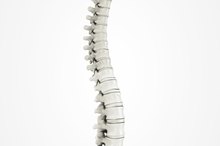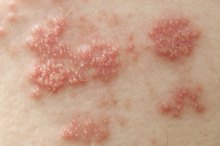Symptoms of Herpes of the Spine
According to the Centers for Disease Control and Prevention (CDC), 45 million Americans are infected with herpes, although most have no idea that they are infected 1. In the May 2008 edition of the "Archives of Neurology," Drs 2. Joseph R. Berger and Sidney Houff of the University of Kentucky College of Medicine reported that herpes virus was found in the spinal nerve roots of 40 percent of people on autopsy, although most had no documented history of herpes. Symptoms of herpes of the spine are different from the symptoms most people associate with herpes.
If you are experiencing serious medical symptoms, seek emergency treatment immediately.
Skin Lesions
Skin lesions associated with spinal herpes can appear on the genitals or they may appear in places less commonly associated with herpes infections, such as the lower back, buttocks and thighs. The website Skinsight.com offers representative photos. Typically, according to "Harrison's Principles of Internal Medicine," herpes lesions begin as painful, small red bumps or fluid-filled blisters. Over the course of a few days, the lesions usually break open and crust over. During this time they may be itchy, painful or both. First-time lesions may take as long as six weeks to heal. Recurrent lesions usually resolve within about a week. Often, lesions are mistaken for pimples, ingrown hairs, allergic reactions, jock itch or other kinds of rashes. Since they resolve on their own, people usually do not seek medical advice.
- Skin lesions associated with spinal herpes can appear on the genitals or they may appear in places less commonly associated with herpes infections, such as the lower back, buttocks and thighs.
- Typically, according to "Harrison's Principles of Internal Medicine," herpes lesions begin as painful, small red bumps or fluid-filled blisters.
Radiculopathy
Long-Term Effects of Herpes Simplex 2
Learn More
Radiculopathy is another symptom of spinal herpes. The term "radiculopathy" refers generally to problems with the nerves. The defining feature of radiculopathy is that symptoms track or "radiate" along the distribution of the affected nerve. Radiculopathy caused by herpes typically affects lumbar or sacral nerve roots. In severe cases, symptoms may cause urinary retention, constipation and transient paralysis.
- Radiculopathy is another symptom of spinal herpes.
- The term "radiculopathy" refers generally to problems with the nerves.
Aseptic Meningitis
According to "Harrison's Principles of Internal Medicine," spinal herpes can also lead to a condition known as aseptic meningitis. The term "aseptic" refers to the absence of bacteria, while meningitis means inflammation of the connective tissue lining the spinal cord and brain. Symptoms of meningitis include headache, stiff neck, fever and altered mental status. People with these symptoms need to seek medical care immediately, regardless of whether or not they have a history of herpes or other diseases. Meningitis due to spinal herpes may also be accompanied by back, buttock, perineal and lower extremity pain, urinary retention and constipation. Headaches occur in as many as 15 percent of patients with recurrent genital herpes and, according to the article in "Archives of Neurology," probably reflect subacute infection of the meninges by the herpes virus.
- According to "Harrison's Principles of Internal Medicine," spinal herpes can also lead to a condition known as aseptic meningitis.
- Headaches occur in as many as 15 percent of patients with recurrent genital herpes and, according to the article in "Archives of Neurology," probably reflect subacute infection of the meninges by the herpes virus.
Related Articles
References
- Centers for Disease Control: Genital Herpes
- Archives of Neurology; Neurological Complications of Herpes Simplex Virus Type 2 Infection; J.R. Berger and S. Houff; May 2008
- Herpes Simplex Viruses (Chapter); L. Corey; In: Harrison’s Principles of Internal Medicine, 17th edition; A.S. Fauci, E. Braunwald, D.L. Kasper, S.L. Hauser, D.L. Longer, J.L. Jameson, and J. Loscalzo (Eds); 2008
- McQuillan G, Kruszon-Moran D, Flagg EW, Paulose-Ram R. Prevalence of herpes simplex virus type 1 and type 2 in persons aged 14–49: United States, 2015–2016. NCHS Data Brief. 2018;304.
- Tronstein E. Genital Shedding of Herpes Simplex Virus Among Symptomatic and Asymptomatic Persons With HSV-2 Infection. JAMA. 2011;305(14):1441. doi:10.1001/jama.2011.420
- World Health Organization (WHO). Herpes simplex virus. Updated January 31, 2017.
- Centers for Disease Control and Prevention. Genital Herpes - CDC Fact Sheet (Detailed). Updated January 31, 2017
- Centers for Disease Control and Prevention. Genital Herpes - CDC Fact Sheet. Updated August 28, 2017.
- Chun H, Carpenter R, Macalino G, Crum-Cianflone NF. The role of sexually transmitted infections in HIV-1 progression: A comprehensive review of the literature. Journal of Sexually Transmitted Diseases. 2012;2013(176459):1-15. doi:10.1155/2013/176459
- Heslop R, Roberts H, Flower D, Jordan V. Interventions for men and women with their first episode of genital herpes. Cochrane Database Syst Rev. 2016 Aug 30;(8):CD010684. doi:10.1002/14651858.CD010684.pub2
- Jin F, Prestage GP, Mao L, Kippax SC, Pell CM, et al. Transmission of herpes simplex virus types 1 and 2 in a prospective cohort of HIV-negative gay men: the health in men study. J Infect Dis. 2006 Sep 1;194(5):561-70.
- Schulte JM, Bellamy AR, Hook EW 3rd, Bernstein DI, Levin MJ, et al. HSV-1 and HSV-2 seroprevalence in the united states among asymptomatic women unaware of any herpes simplex virus infection (Herpevac Trial for Women). South Med J. 2014 Feb;107(2):79-84. doi:10.1097/SMJ.0000000000000062
Resources
Writer Bio
Heather Gloria began writing professionally in 1990. Her work has appeared in several professional and peer-reviewed publications including "Nutrition in Clinical Practice." Gloria earned both a Bachelor of Science in food science and human nutrition from the University of Illinois. She also maintains the "registered dietitian" credential and her professional interests include therapeutic nutrition, preventive medicine and women's health.






